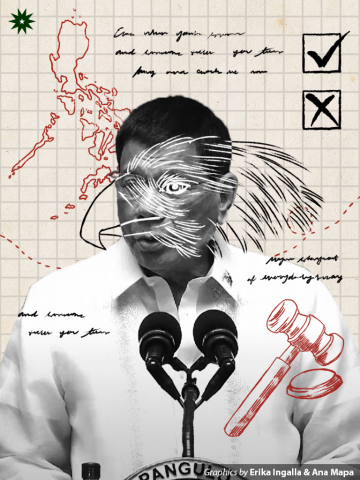President Rodrigo Duterte is not a man in need of a lofty introduction—just the mere mention of his name is enough to incite strong emotions in an individual, whichever end of the political spectrum they belong in. As the 16th president of the Republic of the Philippines, he has been at the helm of our country for over five years, though not without major controversies, owing mostly to his brash and expressive nature.
His divisive actions made on behalf of the country have caused both alarm and dissatisfaction to ripple throughout the nation. With such an eventful presidential career, one wonders of the origins of the so-called “Real Eagle of Davao”.

Evolution of power
Duterte was known to be a delinquent kid during his teenage years—skipping school and getting expelled for misconduct, twice. He was a difficult student to begin with, but despite the troubles he had as a child, he worked his way through to become a lawyer.
However, his desire for public service did not just come overnight. Richard Javad Heydarian, author of The Rise of Duterte: A Populist Revolt against Elite Democracy, expounds that Duterte’s political instinct was honed in his late father’s shadow—wanting to continue the legacy of the former mayor and governor of the then-undivided Davao province.
Author of Beyond Will and Power Earl Parreño adds to this, saying that Duterte was in awe of his father’s power while he was in service as a public servant. With his mother also in public service and having pushed for democratic change under former President Cory Aquino, he saw politics as “something that will give [him] power and, perhaps, satisfaction.”
As a proactive politician in his younger years, Duterte was a fresh sight to Davaoeños. He was exposed to politics throughout his life which made him a “natural politician,” according to Heydarian. Despite coming from an elite family, he knew how to deal with ordinary people and knew what voters wanted—he connected with them and their aspirations. That became his strength and he maximized it, getting himself elected in Davao City for almost 27 years.
Although many have theorized about Duterte’s political dogma and motivation, Parreño is confident that he is driven by none other than power.
“It’s about wanting to preserve his power, wanting to stay in the position,” he reiterates, and likens Duterte’s political identity to the viscosity of water—fluid and always ready to mold itself into the shape of the current political atmosphere.
Although taking into account his unmatched ability to stay relevant despite all his personal and political shortcomings, it seems that the transition from mayorship to presidency has taken a toll on the presidential figure. Eventually, Duterte’s leadership became his Achilles’ heel, notes Parreño.
Poles and polls
According to the Department of Political Science and Development Studies Asst. Prof. Lecturer Cleve Arguelles, Duterte did not have “that much of a connection” with election machinery like clientelistic ties, voter patronage, and even vote buying. Being disadvantaged in that field, he directly engaged with people instead.
Choosing this route, “what he did was make really controversial statements, play on the attention-driven media economy, [and] claim very unique positions,” Arguelles asserts.
He compares this with attending a big party, where one “knows who the big names are and all eyes are on them.” “To get the attention of the people in the party, you have to say something controversial, you have to dress controversial,” he furthers.
Beyond techniques, however, Duterte banked on the Filipinos’ frustrations—on the demand for a new kind of leadership—to amass more followers. “It’s that kind of desire to try something new,” Arguelles cites.
To his assessment, Arguelles says Filipinos’ preferences of a leader is likened to a constantly moving pendulum, swinging from one pole to another—switching preferences between reformist and populist kinds of leaders.
He provides the example of transitioning from the presidency of the late Noynoy Aquino to that of Duterte, “There were many positive reforms [from Aquino] but they really couldn’t push beyond pre-existing structural problems of the Philippines.” This got many frustrated, he claims; despite supporting a reformist, they did not get their desired results at the end. This enabled the people’s preference to swing back, leaning more toward the other pole—representing a “strongman kind of leadership, an iron fist.”
When asked if this trend of the pendulum would persist come 2022, Arguelles posits that it will, if based on the previous administrations. However, he points out that given the names of those who filed for the presidency so far, the next president could be a mixture of a populist and reformist leader. “[That] would break the trend,” he comments, “That would be a new option.”
And indeed, a new option is truly what the Filipino people currently need. The opportunity that the upcoming 2022 elections presents to the citizenry is more than just a transfer of power—it is a window of hope that potentially promises a better future for the country.
